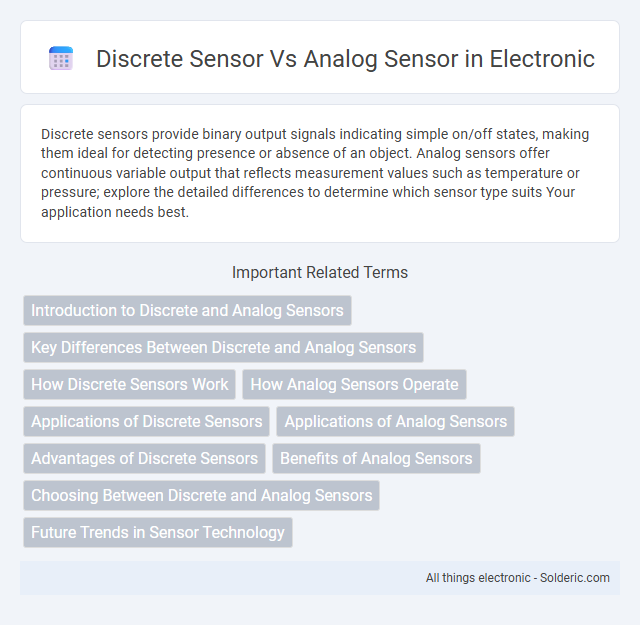Discrete sensors provide binary output signals indicating simple on/off states, making them ideal for detecting presence or absence of an object. Analog sensors offer continuous variable output that reflects measurement values such as temperature or pressure; explore the detailed differences to determine which sensor type suits Your application needs best.
Comparison Table
| Feature | Discrete Sensor | Analog Sensor |
|---|---|---|
| Output Signal | Binary (ON/OFF, 0 or 1) | Continuous variable signal |
| Signal Type | Digital | Analog |
| Sensing Accuracy | Basic presence or absence detection | High precision measurement |
| Application Examples | Limit switches, proximity sensors, push buttons | Temperature sensors, pressure sensors, humidity sensors |
| Data Interpretation | Simple, easy to process | Requires ADC or signal processing |
| Cost | Generally low cost | Typically higher cost |
| Complexity | Simple output logic | Complex output requiring calibration |
| Use Case | State detection (e.g., object presence) | Variable measurement (e.g., temperature level) |
Introduction to Discrete and Analog Sensors
Discrete sensors detect binary states such as on/off or presence/absence, providing digital output signals ideal for applications requiring simple, clear-cut information. Analog sensors measure continuous physical quantities like temperature, pressure, or light intensity, producing variable voltage or current signals that reflect real-time changes accurately. Selecting the right sensor depends on your need for precise, real-time data versus basic state detection in your system.
Key Differences Between Discrete and Analog Sensors
Discrete sensors detect and output binary signals, indicating the presence or absence of a specific condition, whereas analog sensors provide continuous variable signals proportional to the measured parameter. Discrete sensors are commonly used for simple on/off detection, such as proximity switches or limit sensors, while analog sensors measure parameters like temperature, pressure, or light intensity with precise gradations. The key difference lies in signal type and output resolution, affecting application suitability and integration complexity in control systems.
How Discrete Sensors Work
Discrete sensors function by detecting specific, binary states such as ON/OFF or presence/absence, producing signals that represent these two distinct conditions. These sensors often use switches, photoelectric detectors, or proximity sensing technologies to provide clear-cut digital outputs without intermediate values. Their operation relies on threshold-based triggering, making them ideal for applications requiring simple and precise event detection.
How Analog Sensors Operate
Analog sensors operate by continuously measuring physical quantities such as temperature, pressure, or light intensity and converting these variables into proportional electrical signals, typically voltage or current. These sensors produce a continuous output that represents the magnitude of the detected parameter, allowing precise detection of small variations. Common examples include thermocouples, photoresistors, and strain gauges, which enable real-time monitoring and control in applications requiring high resolution and accuracy.
Applications of Discrete Sensors
Discrete sensors are widely used in industrial automation for detecting the presence or absence of objects, such as in assembly line quality control and safety systems. These sensors provide binary output signals essential for applications requiring simple, reliable on/off status detection. Your manufacturing process benefits from discrete sensors by enabling precise control of machinery and ensuring operational safety.
Applications of Analog Sensors
Analog sensors are commonly used in applications requiring continuous measurement of physical parameters such as temperature, pressure, humidity, and light intensity. These sensors provide variable signals proportional to the sensed quantity, enabling precise monitoring and control in industrial automation, environmental monitoring, and medical devices. Their ability to capture fine-grained data makes them essential for real-time feedback in systems like HVAC controls, robotics, and automotive sensors.
Advantages of Discrete Sensors
Discrete sensors offer distinct advantages such as simple on/off output signals, which enable easy integration with digital control systems and reduce processing complexity. Their high reliability and resistance to electrical noise make them ideal for harsh industrial environments where precise binary detection is critical. Moreover, discrete sensors typically have lower cost and faster response times compared to analog sensors, enhancing efficiency in applications requiring immediate status feedback.
Benefits of Analog Sensors
Analog sensors provide continuous data output, enabling precise measurement of varying physical quantities such as temperature, pressure, and light intensity. Their ability to capture subtle changes allows for enhanced accuracy in monitoring and control systems across industrial automation, healthcare devices, and environmental sensing applications. This high resolution and real-time feedback contribute to improved performance and decision-making in complex processes.
Choosing Between Discrete and Analog Sensors
Choosing between discrete and analog sensors depends on the specific requirements of Your application, including the type of data needed and measurement precision. Discrete sensors provide binary outputs useful for detecting the presence or absence of objects, while analog sensors deliver continuous signals that capture variable information such as temperature, pressure, or light intensity. Understanding the difference in output signals and data resolution is essential for selecting the appropriate sensor to optimize system performance and accuracy.
Future Trends in Sensor Technology
Future trends in sensor technology highlight the increasing integration of discrete sensors and analog sensors within smart systems for enhanced precision and real-time data analysis. Advances in AI-driven signal processing and IoT connectivity are enabling your devices to leverage these sensors for improved automation and predictive maintenance. Enhanced sensitivity, miniaturization, and energy efficiency are driving innovations that bridge discrete and analog sensor functionalities to meet evolving industrial and consumer demands.
Discrete sensor vs analog sensor Infographic

 solderic.com
solderic.com